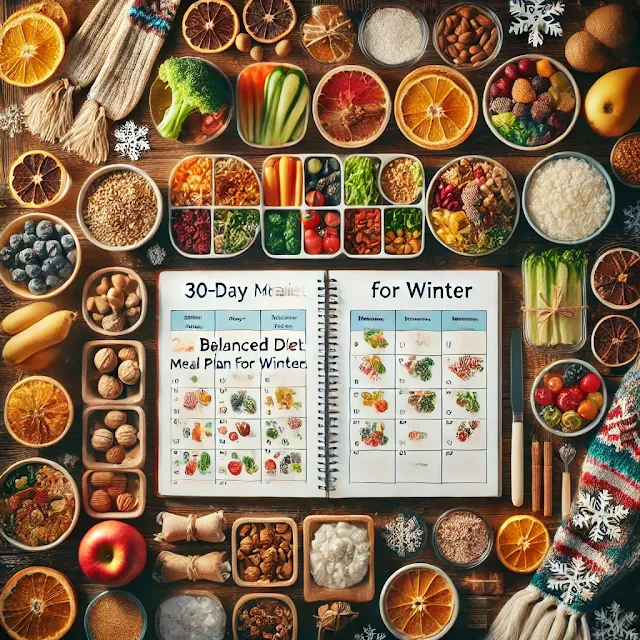Balanced Diet Foods for Winter in Type 2 Diabetes : 30-Day Meal Plan for Winter
 |
| Balanced Diet Foods for Winter in Type 2 Diabetes : 30-Day Meal Plan for Winter |
Keeping a balanced diet in winter is key for managing type 2 diabetes. This guide shows the best foods to control blood sugar. It also offers a 30-day meal plan and tips for staying healthy in the cold.
Why Is a Balanced Diet Important for Type 2 Diabetes?
A balanced diet is vital for type 2 diabetes management. It includes carbs, proteins, healthy fats, and fiber. These work together to keep blood sugar steady.
Key Facts
- The World Health Organization (WHO) says type 2 diabetes makes up about 90% of diabetes cases worldwide.
- Research shows a high-fiber diet can lower blood sugar by up to 29% in people with diabetes.
What Is a Balanced Diet?
A balanced diet means the right mix of nutrients in the right amounts. A balanced menu might include:
- Breakfast: Oatmeal with berries and nuts.
- Lunch: Lentil soup with whole-grain bread.
- Dinner: Grilled fish with steamed vegetables.
This diet helps manage weight, keeps energy up, and lowers the risk of health problems.
Winter Foods for Managing Type 2 Diabetes
1. Fiber-Rich Vegetables
Vegetables like broccoli, spinach, kale, and carrots are full of fiber and antioxidants. They help keep blood sugar stable.
Practical Tips:
- Steam broccoli for soups.
- Sauté spinach with garlic.
- Use kale in warm salads.
2. Low-Glycemic Fruits
Apples, oranges, and pears are good fruit choices because they have a low glycemic index.
Practical Tips:
- Sprinkle cinnamon on apple slices.
- Add oranges to salads.
- Blend pears into smoothies with low-fat yogurt.
3. Lean Protein Sources
Protein slows down sugar absorption. Good protein sources include salmon, skinless chicken, tofu, and legumes.
Practical Tips:
- Grill chicken breast.
- Add tofu to soups.
- Snack on boiled legumes.
4. Healthy Fats
Avocado, olive oil, and almonds are heart-healthy fats that help manage diabetes.
Practical Tips:
- Drizzle olive oil on salads.
- Spread avocado on whole-grain toast.
- Snack on almonds.
5. Warm Beverages
Herbal teas like green tea, ginger tea, and warm lemon water are cozy without raising blood sugar.
Practical Tips:
- Enjoy unsweetened green tea after meals.
- Add ginger slices to warm water.
Nutritional and Vitamin Support for Type 2 Diabetes
| Nutrient/Vitamin | Natural Sources | Benefits |
|---|---|---|
| Fiber | Broccoli, spinach, carrots | Lowers blood sugar levels |
| Vitamin D | Salmon, eggs | Improves insulin sensitivity |
| Magnesium | Almonds, spinach | Enhances glucose metabolism |
| Omega-3 | Fatty fish, chia seeds | Supports heart health |
| Vitamin C | Oranges, kiwi | Antioxidant protection |
Eating these nutrients daily can help control blood sugar and improve health.
Comparison: Type 1 vs. Type 2 Diabetes
| Aspect | Type 1 Diabetes | Type 2 Diabetes |
|---|---|---|
| Cause | Autoimmune disorder | Insulin resistance |
| Symptoms | Rapid weight loss | Weight gain |
| Treatment | Insulin | Oral medication, insulin |
| Onset Age | Typically in childhood | Commonly in adults |
Solutions:
- Diet: Focus on fiber and protein.
- Exercise: Engage in light activities like walking.
- Medical Care: Consult your doctor for a tailored treatment plan.
30-Day Meal Plan for Winter
Week 1: Fiber-Focused Meals
- Breakfast: Oatmeal with apple slices and cinnamon.
- Snack: Carrot sticks with hummus.
- Lunch: Spinach soup with tofu.
- Afternoon Snack: A handful of almonds.
- Dinner: Sautéed broccoli and kale with grilled chicken.
Practical Tips:
- Opt for steaming and roasting to retain nutrients.
- Replace processed foods with fresh vegetables.
Week 2: Low-Glycemic Fruit Variations
- Breakfast: Pear smoothie with low-fat yogurt.
- Snack: One orange.
- Lunch: Salad with apple slices and olive oil dressing.
- Afternoon Snack: Fresh kiwi.
- Dinner: Grilled fish with steamed sweet potatoes.
Practical Tips:
- Use fresh fruits, not those with added sugar.
- Pair fruits with protein to slow sugar absorption.
Week 3: Protein-Packed Meals
- Breakfast: Boiled eggs with whole-grain toast.
- Snack: A handful of mixed nuts.
- Lunch: Stir-fried tofu with green vegetables.
- Afternoon Snack: Grilled chicken strips.
- Dinner: Baked salmon with quinoa and steamed spinach.
Practical Tips:
- Rotate protein sources to keep meals exciting.
- Avoid processed protein like sausages or nuggets.
Week 4: Hydration and Healthy Fats
- Breakfast: Avocado on whole-grain toast.
- Snack: Sunflower seeds.
- Lunch: Tuna salad with olive oil dressing.
- Afternoon Snack: Unsweetened green tea with walnuts.
- Dinner: Vegetable soup with tofu and olive oil.
Practical Tips:
- Stay hydrated with at least 8 glasses of water daily.
- Use olive oil instead of regular cooking oils.
FAQs About Type 2 Diabetes
- What causes type 2 diabetes?
Insulin resistance from bad habits and genes is the main reason. - What are the symptoms of type 2 diabetes?
Signs include thirst, frequent need to pee, and slow healing of wounds. - What is a balanced diet?
A mix of carbs, proteins, fats, vitamins, and minerals in the right amounts - What are good winter foods for diabetes?
Choose low-glycemic fruits, fiber-rich veggies, lean proteins, and healthy fats. - How can I plan meals for diabetes?
Focus on portion control, nutrient-rich foods, and low-glycemic options. Don't forget to stay hydrated.
Suggestions for Consistency
- Plan Ahead: Write out weekly menus for easy prep.
- Batch Cooking: Cook meals ahead to save time.
- Portion Control: Use small containers for meals.
- Stay Active: Eat healthy and walk 20–30 minutes daily.
By following this 30-day plan, you'll keep a balanced diet in winter and manage type 2 diabetes well. 😊
